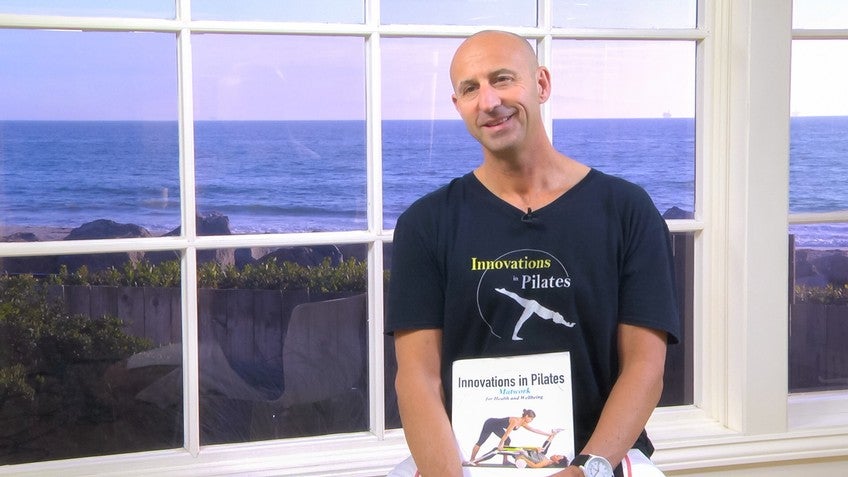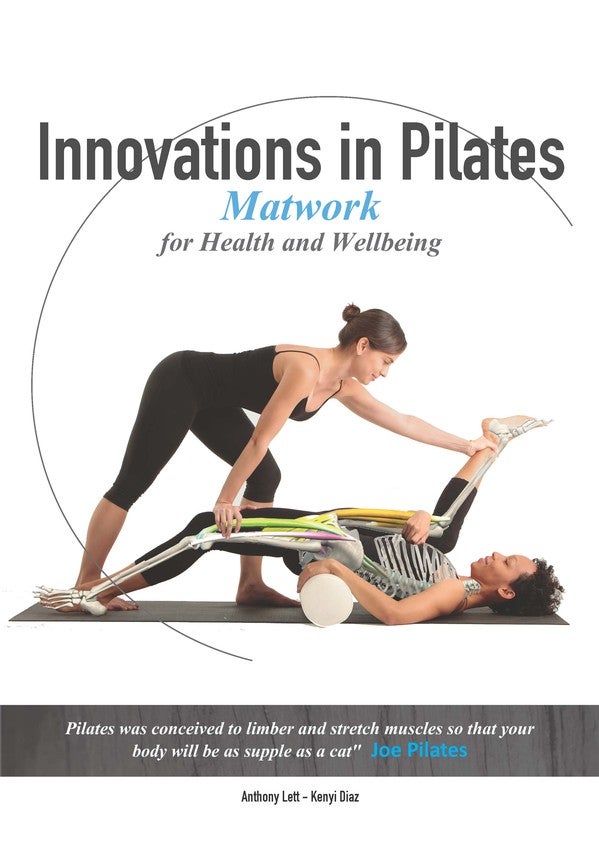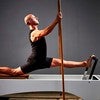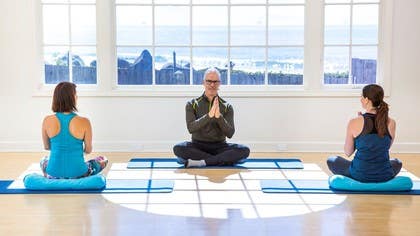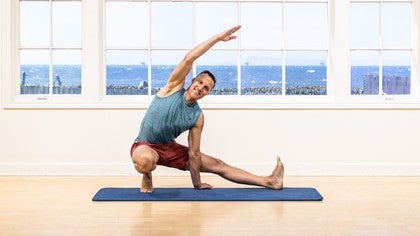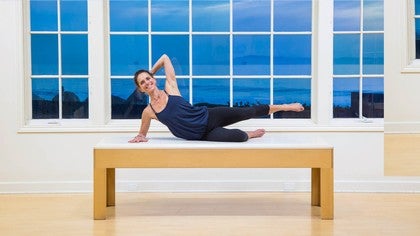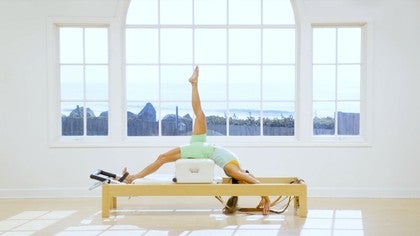Innovations in Pilates - Mat-Work for Health and Wellbeing
How did you get started with Pilates? What is your Pilates background? How long have you been practicing Pilates?
I started Pilates for several reasons. One was to become more flexible for my sport - tennis. I was a serious player with poor flexibility. At the time, there were no real flexibility training classes except for yoga. So after seeing Megan Williams and her famous boyfriend, guitarist Ian Moss, on TV, I found one of only two studios in Melbourne. The teacher had trained with Alan Herdman, and was an ex-dancer who ran a studio, mostly for the Australian Ballet. I was a client for about 5 years before apprenticing with them. This was about 22 years ago, so I was aged 3. :)
How long have you been teaching Pilates? And how long have you been teaching Pilates instructors?
I opened my first studio in 2001, and before that, taught as an apprentice for several years. Coincidentally, my studio burned down, just like Joe Pilates Studio. It was a tragic day - September 11, 2001.
I’ve been teaching my Innovations in Pilates work to instructors for about 5 years internationally. Before that, I taught Stretch Therapy to instructors in my Melbourne studio in Fitzroy.
What about Pilates inspires you?
So much! How long do we have?! I better summarize:
- The young teachers, sometimes in the most unlikely places, pouring everything that they have into creating beautiful spaces in which to teach a wonderful system of healthcare and movement.
- The clients who come religiously to subject themselves to this tough but rewarding work
- The open minded teachers like Rael Isacowitz and Carol Monaco who have the courage to sit in the awkward, uncomfortable space where the essence of the method is preserved but at the same time the mind is open enough to explore new ideas and developments for the Pilates method.
Please tell us about your upcoming book. What are the title and the subject of the book? The book is called Innovations in Pilates - Mat-Work for Health and Wellbeing. It is the second in the Innovations in Pilates series, which focuses on the stretching element within the Pilates method. The first was on the Reformer, this time we’re on the Mat.How did you come up with the idea for this book? What inspired you to write this book?
The inspiration behind the book stems from my background and my initial reason for taking Pilates classes - I wanted to become more flexible. Joseph Pilates was well-known to have devised his method to increase flexibility, (and it should be said, other qualities) and many of his quotes reveal this interest. "Contrology was conceived to limber and stretch muscles so that you will be as supple as a cat,” is just one of his quotes on the subject. However, I felt as though this quality had room for improvement, and indeed, with the growth of the core strength movement, two things had happened. The first was that core strength development had become the dominant focus of most sessions. The research that emerged seemed to have been misconstrued to pit core strength development in opposition to flexibility and suppleness too (a mistake in my view), which resulted in the second occurrence - the interest in and the training of flexibility was lost to a large extent. To honor Pilates' original intention, and to infuse the Pilates studio with some modern flexibility work, I wrote Innovations in Pilates. The Mat Book offers all of the work from the first book on the Reformer, but without the need for equipment.
Why do you think this subject is important?
For several reasons. First, as I said above, to honor one of the initial reasons for the development of the method, which was to some extent in danger of being lost. Many teachers worldwide have told me that their training offered almost nothing in the area of stretching. In addition, their clients were going to yoga to train their flexibility! As Pilates teachers, we ought to be able to offer effective stretching to our clients too.
Second, flexibility as a quality is just as important as the development of any other physical attribute. Many great athletes and physical therapists of any background, orthopedic surgeons and the like will agree with this assertion. Moreover, flexibility and strength training of the Pilates kind, or any kind, are entirely compatible. When I studied sports science, one of my lecturers used to say we need to train 5 components of fitness. He would call it the 5S of training - strength, speed, skill, stamina, and suppleness. I felt that Pilates had the potential to encompass all of them, with a little bit of development in the flexibility domain. I think we in the West tend to focus on the attributes that will improve the quantity of life, or our physical appearance, like aerobic fitness, whilst ignoring the qualities that will effect the quality of life, like range of movement. Innovations in Pilates can help with this. After all, who wants a healthy heart if they’re stuck in wheelchair for the last 20 years of their life? I often say that “aerobic exercise will help you stay alive, Pilates, and Innovations in Pilates will make it worth being alive!"
Finally, the flexibility training offered in the traditional work, where it is still being taught, can be improved with the integration of some modern neurophysiological principles. I hope we’ve done that with Innovations in Pilates. Many of the stretches can be traced back to the Mat and Reformer movements, but with the integration of some more recent sports medicine principles.
How is your book different from other Pilates books?
There are now dozens of Pilates books, so this was an important question for us. What can we offer that hasn’t already been done? Our book is distinct because it does not teach Pilates exercises, it teaches stretching. However, the stretches are related directly to Pilates exercises and can be used in two distinct ways. One, they can be used as preparation for the traditional work. Many of the traditional exercises, like The Saw, or Rocking for example, require significant flexibility to begin with. If a client does not have that flexibility, they cannot perform the work, or they perform it badly with the potential for injury. So, in Part A, we analyze all of the Mat work exercises from the flexibility perspective. We ask the question, how much flexibility, and at which joints, is required for one to perform this exercise? We then refer the reader to Part B, where those stretches are taught. If an exercise does not have any acute flexibility demands, we teach what Joe Pilates called “companion poses," - stretches to relax the muscles that were just worked so hard in an exercise like The Hundred for example.
The second way in which the exercises/stretches can be used is as a well-being practice in themselves, quite apart from how they may effect one’s ability to perform Pilates material. This honors the traditional goal of Joseph Pilates in two senses - that one should be “as supple as a cat,” and that “one ought to be able to perform the activities of daily life with spontaneous zest and pleasure.”
Joseph Pilates also said that, “he wanted to spread his doctrines on the subject of tension and relaxation, so that the world at large may benefit.” We feel that relaxation, in the total mind/body sense is also less developed in the current crop of Pilates books. In most, the focus is on repertoire and biomechanics. There is now a huge volume of research in the field of mind/body medicine to demonstrate the value of relaxation techniques in managing some of the physical manifestations of stress like heart disease, some cancers, auto immune disorders etc. We hope that Innovations in Pilates will assist with treating the effects of stress, now responsible for 70 to 80 percent of visits to the doctor according to the World Health Organization.
Who is involved in the creation of this book?
Its been a long slog for myself and my partner Kenyi Diaz. Kenyi posed for all of the photos as well as doing all of the graphic design work, assisted with writing, and constructed all of the anatomical images.
What is your goal for this book?
I think I’ve made it clear above, but to summarize:
- To further develop the flexibility aspect of the Pilates work
- To honor one of the original goals of Joseph Pilates and his work
- To assist with the management of chronic stress - the ailment of the western world
- To assist people, from any walk of life, in improving the freedom and quality of their movement
What could instructors learn from your book? How will this help instructors with their practices? How can instructors integrate this content into their practices?Instructors will learn many things we hope! First, if nothing else, they will learn dozens of new, safe, and effective stretches, backed by the latest research in neurophysiology. We’ve also invested a lot of time in creating some fabulous 3D anatomy images that will assist with anatomical understanding. The images show skeletons on the floor, performing Pilates work, so it’s as real as having a moving skeleton with some muscles attached in your studio!
Second, they will learn to analyse the movement of their clients from a flexibility perspective. What that means is that they will form alternative ways of observing movement, distinct from the “tight/weak” model that is taught in most training courses. After reading our book, I hope that they will be able to see the movement of a client through an alternative lens, one which indicates that range of movement, or the lack of, may be affecting their client’s capacity to perform the work and to move with ease and fluidity. Because we directly relate all of the stretches to the performance of the classical work, I hope that teachers will find the book immediately applicable in their studio work.
Is this only for those experienced with Pilates?
I think that Pilates students and teachers will use the book in particular, but if someone wanted just to learn to stretch, part B of the book will provide plenty for them. It has a significant introductory discussion on stretching methods, warm ups, how long to stretch for, how to use some modern sports medicine techniques in simple ways, and beginner to advanced stretches for the entire body, hands and feet included! We’ve also included a section, with bone photographs, on anatomical variation, and how this may effect a person’s ability to do certain exercises. We teach how to identify anatomical variation in yourself, and what to do/how to proceed if you come across certain anatomical limitations.
What group of people do you think will find this book most appealing?
Everyone I hope! I think Pilates teachers & students, anyone who wants to self-manage the effects of stress, those who wants to increase their ease, grace and range of movement, sports people, martial artists, and dancers, Also those who practice Pilates but seem to have reached some “road blocks” in their work.
Where will this book be available? Our book will be available on Amazon and iTunes, and from our website.
When will this book be available? Fingers crossed, by Christmas 2014. It will fit snugly into your partners stocking, even if you want it for yourself!
Comments
Im sorry I have not responded to your questions. We are not going with Amazon yet for a few reasons. One is that the paper is too thin and our gorgeous images show though both sides of the page. To order, please go to our website www.innovationsinpilates.com Thank you for your interest.
Anthony
You need to be a subscriber to post a comment.
Please Log In or Create an Account to start your free trial.
